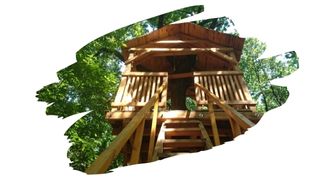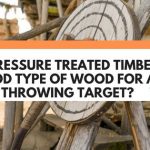Building a treehouse is a fantastic way to get your kids to fall in love with playing outside. And, figuring out your plan for that above-ground playroom, is a lot of fun for you too.
But, your treehouse will be facing the harsh outdoor elements all year round. Which means, that the wood you use to build a treehouse needs to be rot-resistant.
Now, when it comes to outdoor construction in general, using pressure treated wood is pretty much standard. That’s because the chemical treatments used on treated timber can help it to stave off decay.
But, pressure treated wood really safe enough to be used to make a kids treehouse?
Well, in this post, you’ll find out what pressure treated wood is, and why it can help increase the longevity of solid natural wood. You’ll also discover which specific pressure treated wood type is EPA approved for your garden.
And keep reading to learn why untreated wood, and an eco-friendly wood preserver, is the safest combination for your treehouse.

This post may contain affiliate links to products that we receive a commission for (at no additional cost to you). Learn more here.
What Is The Best Type Of Wood For A Treehouse?
Any wood used for an exterior structure will need to be durable and rot-resistant. It will also need to be fairly tough too.
Now, there are plenty of different hardwoods that are perfect candidates for this. But most of these choice outdoor wood types, (such as Ipe or Teak wood), tend to be fairly expensive.
However, in the USA and Canada, your best option can be found in White Oak wood. This lumber is naturally rot-resistant, and is very affordable too.
And Why Is White Oak Good For Exterior Structures?
Yes it is, and for two good reasons; Tyloses and Tannins.
- Tyloses
Tyloses are small cell growths that form over the wood pores of White Oak. These growths, (which do not form on Red Oak), help prevent White Oak from over-absorbing moisture.
- Tannins
Tannins are a natural compound found in plants and trees. But, some trees, such as White Oak, produce an overabundance of this natural chemical.
Tannins are like a natures-own fungicide. They not only help trees fight off insect attacks, they can also help them fight off wood rot bacteria too.
And How Long Will Untreated Oak Wood Last Outside (As A Treehouse)?
Pretty long. If left untreated, (and off the ground), untreated Oak wood can last over two decades.
But, if it has direct ground contact, it’s lifetime will get halved to around ten years or so.
Related Post: Is Oak Wood A Good Choice For Fence Posts?
What About Pressure Treated Oak Wood? Can You Use It To Make A Treehouse?
Here’s the thing; a lot of the chemicals used on pressure treated wood are sourced from some pretty nasty stuff.
You see, pressure treated wood will have been saturated with wood preserving chemicals. These chemicals help to fight off decay by staving off wood rot bacteria.
But, (unlike tannins that do a similar job), these chemicals can often be fairly toxic.
For example, CCA treated wood has been infused with Chromated copper arsenate (CCA), which contains arsenic. In fact, this type of treated wood is so toxic, that it’s banned from being used around residential properties.
Nevertheless, there is a certain type of farm-safe treated wood that can be used around your garden.
So What Type Of Safe Pressure Treated Timbers Are Out There?
The safest types of pressure treated wood are what are referred to as ‘green treated’ wood. These green treated timbers are safer because they contain water-soluble copper-based chemical wood preservatives.
For example, one of the safest types of green treated wood is Alkaline Copper Quaternary (ACQ), which contains Copper Oxide. And copper oxide, (sometimes referred to as Cupric Oxide), can also be found in very small amounts in certain multivitamins.
In fact, ACQ treated wood is E.P.A. (U.S. Environmental Protection Agency) approved for use in residential gardens and farms.
Related Post: How To Keep Your Landscape Timbers From Ever Warping Again
Is Green Treated ACQ Wood Safe For A Treehouse?
It is safe enough to be used on a raised vegetable garden bed. And the amounts of copper in this treated wood poses a fairly low risk to human health. So, yes, you can use it for building a treehouse too.
Related Post: Can You Really Use Untreated Oak For Raised Beds?
Which is why, when it comes to treated wood for a treehouse, you should only consider using ACQ treated wood. And you will still need to seal that timber with a waterproofing sealant as well.
However, green treated wood purchased new is fairly expensive. And recycled old treated wooden boards can have any manner of chemical treatments in them — so they should be avoided.
That’s why, if you want to build an affordable treehouse for your kids, then stick to using untreated wood. And then you can coat it with an eco-friendly wood preservative yourself.
What Type Of Wood Preserver Can I Use On Untreated Wood?
Ideally, you will need a wood preservative that doesn’t contain any toxic chemicals or metals in it. Which is why Cuprinol’s odorless clear preservative is ideal.
Cuprinol’s Clear Wood Preserver sinks right down into timber, and coats all of those wood fibers. This action prevents water from becoming over-absorbed by that lumber.
And by keeping out moisture, you can prevent wood from becoming damp enough for wood rot bacteria to thrive.
However, this wood preserver product should only be used as a base coat. And it will need a top coating wood finish to seal it in.
You can learn more about Cuprinol’s Wood Preserver by checking out their website here.
And What Kind Of Top Coating Finish Do You Recommend?
Well, you should ideally use an exterior wood sealer, one that is also eco-friendly and free of harsh chemicals.
This is why Seal It Garden Bed Wood Sealer fits the bill. This plant-based exterior sealer doesn’t contain the toxic chemicals and solvents often found in other outdoor wood finishes.
Instead, it is so non-toxic, you can even use it to coat a wooden vegetable garden bed. And you needn’t worry about it leaching anything nasty into the garden soil (or into your food).
What’s more, unlike some other outdoor sealers, this product doesn’t need frequent maintenance. In fact, it can protect that treehouse timber for over ten years.
To find the latest prices for Seal It Wood Sealer, you can pop on over to Amazon.com
To Wrap Up, Here Are The 3 Key Takeaways From This Post…
- 1). Pressure treated wood — especially older treated planks — will have often been infused with toxic chemicals.
- 2). There are safe pressure treated wood options, in the form of green-treated wood, such as ACQ treated wood. These particular green-treated timbers can be safely used to make a treehouse.
- 3). Green treated wood is expensive. So, if you want to build a treehouse, simply use a rot-resistant durable wood, such as White Oak. And then apply an eco-friendly wood preservative base coat onto it instead.
References:
Treated Wood In The Landscape | Home & Garden Information Center



